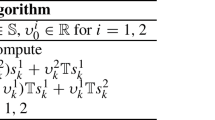Abstract
This paper is a contribution to the sensitivity analysis of piecewise smooth equations. A piecewise smooth function is a Lipschitzian homeomorphism near a given point if and only if it is coherently oriented and has an invertible B-derivative at this point. We emphasise the role of functions of the typef=g °h whereg is piecewise smooth andh is smooth and present verifiable conditions which ensure that the functionf=g °\(\tilde h\) is a Lipschitzian homeomorphism near a given point for every\(\tilde h\) sufficiently close toh with respect to theC 1-topology.
Similar content being viewed by others
References
S.G. Bartels, L. Kuntz and S. Scholtes, “Continuous selections of linear functions and nonsmooth critical point theory,”Nonlinear Analysis, Theory, Methods, and Applications 24 (1995) 385–407.
F.H. Clarke,Optimization and Nonsmooth Analysis (Wiley, New York, 1983).
B.C. Eaves and U.G. Rothblum, “Relationships of properties of piecewise affine maps over ordered fields,”Linear Algebra and its Applications 132 (1990) 1–63.
T. Fujisawa and E.S. Kuh, “Piecewise-linear theory of nonlinear networks,”SIAM Journal on Applied Mathematics 22 (1972) 307–328.
M.S. Gowda and R. Sznajder, “The generalized order linear complementarity problem,”SIAM Journal on Matrix Analysis and Applications 15 (1994) 779–795.
P.T. Harker and J.S. Pang, “Finite-dimensional variational inequality and nonlinear complementarity problems: A survey of theory, algorithms and applications,”Mathematical Programming 48 (1990) 161–220.
H.Th. Jongen, D. Klatte and K. Tammer, “Implicit functions and sensitivity of stationary points,”Mathematical Programming 49 (1990) 123–138.
D. Kuhn and R. Löwen, “Piecewise affine bijections ofR n, and the equationSx +−Tx −=y,”Linear Algebra and its Applications 96 (1987) 109–129.
M. Kojima and R. Saigal, “On the relationship between conditions that insure a PL mapping is a homeomorphism,”Mathematics of Operation Research 5 (1980) 101–109.
M. Kojima, “Strongly stable stationary solutions in nonlinear programming,” in S.M. Robinson, ed.,Analysis and Computation of Fixed Points (Academic Press, New York, 1980), pp. 93–138.
B. Kummer, “The inverse of a Lipschitz function inR n: Complete characterization by directional derivatives,” HASA-Working paper WP-89-084, 1989.
B. Kummer, “Lipschitzian inverse functions, directional derivatives, and applications inC 1,1-optimization,”Journal of Optimization Theory and Applications 70 (1991) 559–580.
B. Kummer, “Newton’s method based on generalized derivatives for nonsmooth functions Convergence analysis,” in: W. Oettli and D. Pallaschke, eds.,Advances in Optimization (Springer-Verlag, Berlin, 1992) pp. 171–194.
L. Kuntz and S. Scholtes, “Structural analysis of nonsmooth mappings, inverse functions, and metric projections,”Journal of Mathematical Analysis and Applications 188 (1994) 346–386.
N.G. Lloyd,Degree Theory (Cambridge University Press, Cambridge, 1978).
Z.Q. Luo, J.S. Pang and D. Ralph,Mathematical Programs with Equilibrium Constraints (Cambridge University Press, Cambridge, 1996), to appear.
J.M. Ortega and W.C. Rheinboldt,Iterative Solution of Nonlinear Equations in Several Variables (Academic Press, New York, 1970).
J.S. Pang, “A degree-theoretic approach to parametric nonsmooth equations with multivaltied perturbed solutions sets,”Mathematical Programming 62 (1993) 359–383.
J.S. Pang and L. Qi, “Nonsmooth equations: motivation and algorithms”,SIAM Journal on Optimization 3 (1993) 443–465.
J.S. Pang and D. Ralph, “Piecewise smoothness, local invertibility, and parametric analysis of normal maps,”Mathematics of Operations Research 21 (1996) 401–426.
J.S. Pang and J.C. Yao, “On a generalization of a normal map and equation,”SIAM Journal on Control and Optimization 33 (1995) 168–184.
L. Qi, “Convergence analysis of some algorithms for solving nonsmooth equations,”Mathematics of Operations Research 18 (1993) 227–253.
D. Ralph, “Global convergence of damped Newton’s method for nonsmooth equations, via the path search,”Mathematics of Operations Research 19 (1994) 352–389.
D. Ralph, “On branching numbers of normal manifolds,”Nonlinear Analysis: Theory, Methods and Applications 22 (1994) 1041–1050.
S.M. Robinson, “Mathematical foundations of nonsmooth embedding methods,”Mathematical Programming 48 (1990) 221–229.
S.M. Robinson, “An implicit function theorem for a class of nonsmooth functions,”Mathematics of Operations Research 16 (1991) 292–309.
S.M. Robinson, “Normal maps induced by linear transformations,”Mathematics of Operations Research 17 (1992) 691–714.
S.M. Robinson, “Newton’s method for a class of nonsmooth functions,”Set Valued Analysts 2 (1994) 291–305.
S.M. Robinson, “Sensitivity analysis of variational inequalities by normal-map techniques”, in: F. Giannessi and A. Maugeri, eds.,Variational Inequalities and Network Equilibrium Problems (Plenum Press, New York, 1995), pp. 257–269.
S. Scholtes, “Homeomorphism conditions for coherently oriented piecewise affine mappings”,Mathematics of Operations Research, to appear.
S. Scholtes, “Introduction to piecewise differentiable equations,” Habilitation Thesis, Preprint No. 53/1994, Institut für Statistik und Mathematische Wirtschaftstheorie, Universität Karlsrube, 1994.
A. Shapiro, “On concepts of directional differentiability,”Journal of Optimization Theory and Applications 66 (1990) 477–487.
R. Sznajder, “Degree-theoretic analysis of the vertical and horizontal linear complementarity problem,” Ph.D. thesis, Department of Mathematics, University of Maryland, Baltimore County, Catonsville, MD 21 228, 1994.
R. Sznajder and M.S. Gowda, “Generalizations ofP 0-andP-properties: extended vertical and horizontal LCPs,” Linear Algebra and Its Applications 223–224 (1995) 695–715.
Author information
Authors and Affiliations
Additional information
Revised version of part of the paper “Sensitivity analysis and Newton’s method for composite piecewise smooth equations”.
Rights and permissions
About this article
Cite this article
Ralph, D., Scholtes, S. Sensitivity analysis of composite piecewise smooth equations. Mathematical Programming 76, 593–612 (1997). https://doi.org/10.1007/BF02614400
Received:
Revised:
Issue Date:
DOI: https://doi.org/10.1007/BF02614400




